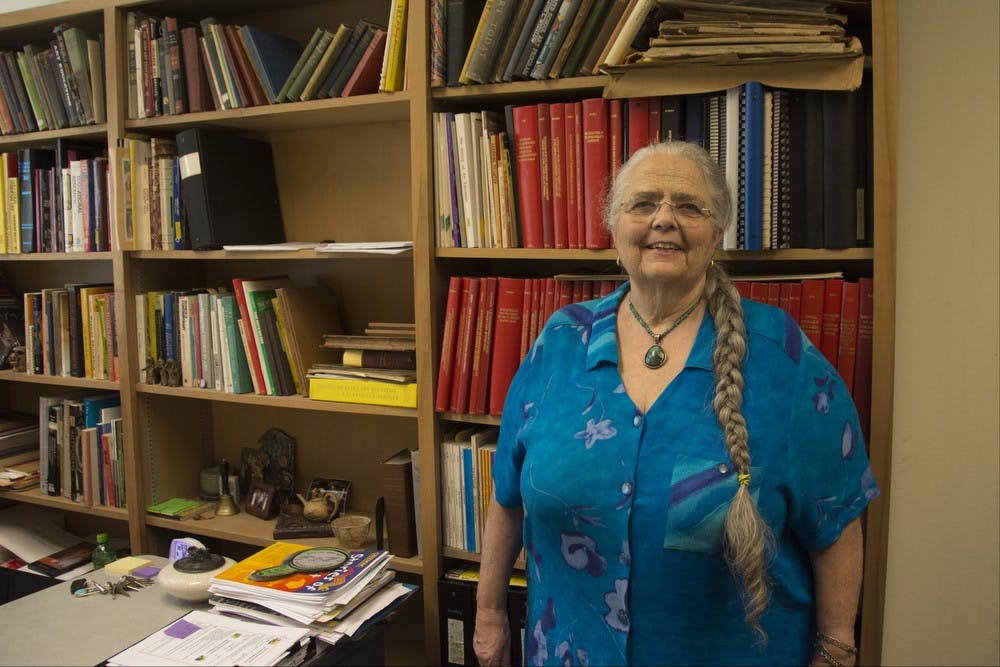It's normal to see what other students have to say about a potential instructor by going to ratemyprofessors.com. However, it does not do justice to ASU arts education professor Mary Erickson, who has spent the last 48 years teaching students around the country and the last 25 years at ASU.
With education experience dating back to 1967, Erickson has taught many students and learned a lot herself. She never doubted the idea of becoming a teacher, thriving on the idea of being able to constantly inquire into art, even when it's challenging.
Erickson said she enjoys teaching both undergraduate and graduate students for different reasons. Her favorite part of it all is watching students change their perspectives about art and teaching.
"I love teaching students their first course in their art education program because people come with all sorts of interesting ideas, myths that need to be dispelled," Erickson said. "I really enjoy introducing people to teaching. We plan little lessons taught in class. When I finished my studies, a lot of it wouldn't be understood today. So I very much enjoy rethinking, revising and thinking of new ways to revive people with art."
Erickson started at ASU as a professor in 1990. Since then, she has received many honors; her resume shows the innovative traits of the person she has grown to be. One example that springs to mind is when she won the 2002 National Art Education Association's Art Educator of the year.
Erickson continues to work and has recently acquired a grant, "Increasing Student Understanding of Art and Art Making through Scaffolded Inquiry" from the National Art Education Foundation. She commented on what this means for high school students and art education.
"I'm working on it now, it will probably take a couple years," Erickson said. "I am working with the Tempe Center for the Arts and the Scottsdale Museum of Contemporary Art. Both have programs for high school art students but are very different. One is a virtual thing and the other involves bringing students to the art museum at least ten times."
Erickson also explained how the title ties into the scaffolding programs, a concept centered around building structures that can sometimes be complex for students to understand.
"Scaffolding means when they are building buildings, a temporary structure that is supposed to help people build their own plan," she said. "That is what we are focused on. We are focusing on helping students build their own inquiry strategies. They don't have to do everything all at once."
Although Erickson said she believes others may find her passion intimidating, she enjoys the ability to connect with her students. In doing so, she shares personal accounts of her life to allow students have a different perspective and connect more with the art.
"I will talk about experiences, farm experiences, which are very foreign to most of my students," Erickson said. "It helps students think of something in their life. I use my own stories, quite often to help students tell their stories. Life issues stay the same. We look at art and different cultures. So it helps raise the level of conversation to bigger topics."
A beginning project for students in the class is to first decide what symbol defines them.
"I have students make an index card for their desk," Erickson said. "Their challenge is to come up with a symbol to show what their place is, how they see themselves in the world. Mine says Mary and it has a chicken on it because they know my farm stories."
With the amount of experience under her belt, Erickson knows it is important that she is not always the authoritative figure in situations and likes when others tell her what is right and what is not.
Take, for example, the situation of her professional relationship with a former student and now colleague of hers Michelle Nichols Dock, the gallery coordinator of Tempe Center for the Arts. Dock notes that Erickson jokingly refers to her as the boss. However, she doesn't like to think of their relationship that way.
"I've been working with Mary since 1997, we just hit it off," Dock said. "She was a wonderful mentor. She really worked with you to find your own voice. This was a biggie when I was a student. She helped me find my own voice as an art educator or as a museum educator as I ended up being."
Dock believes that Erickson is a true gem at ASU in her ability to connect and grab students to feel the vibrance of art education.
"She's so energetic and enthusiastic about art education," Dock said. "It's contagious. You put her in a room and you can't help but be excited by the ideas that come across. I feel honored that I have such a wonderful colleague and someone I look up to."
Although an arts education degree may be sometimes ridiculed in this day and age, Erickson knows there is a market for art educators.
"An arts degree is a professional degree it means to serve education as an art teacher," she said. "It is tough. There is a teacher shortage in the state of Arizona right now, including arts teachers. So the prospects of getting a job after graduating are pretty good."
Art generally contains many definitions depending on the person, with Erickson believing that art is for both the young and the old.
"Art is a manifestation of humanity," Erickson said. "An expression of the values and culture of human beings."
Related Links:
Art professor works to bridge learning gaps
Read, write, rate: The top RateMyProfessors at ASU
Reach the reporter at rsantist@asu.edu or follow @ryanerica18 on Twitter.
Like The State Press on Facebook and follow @statepress on Twitter.




